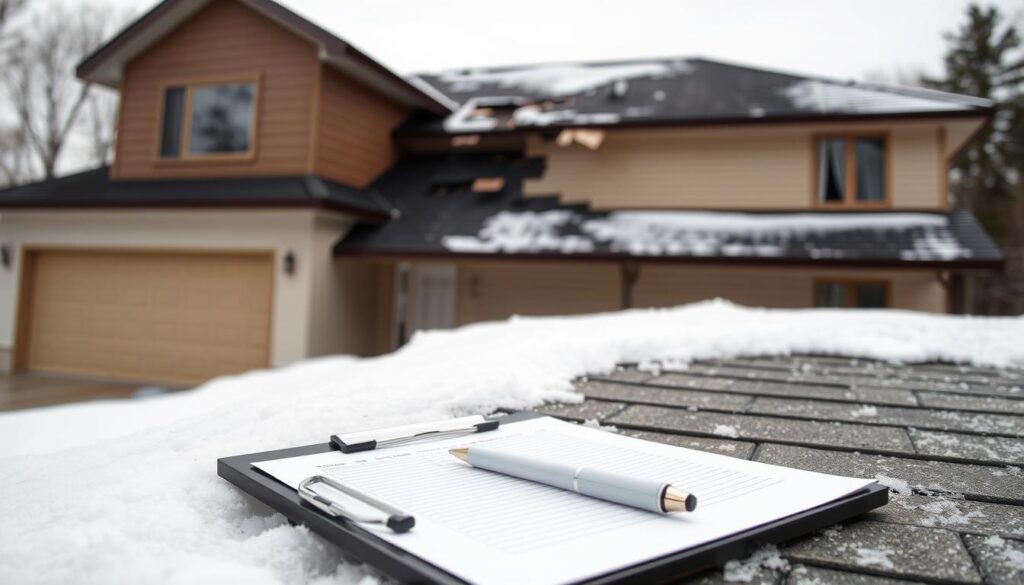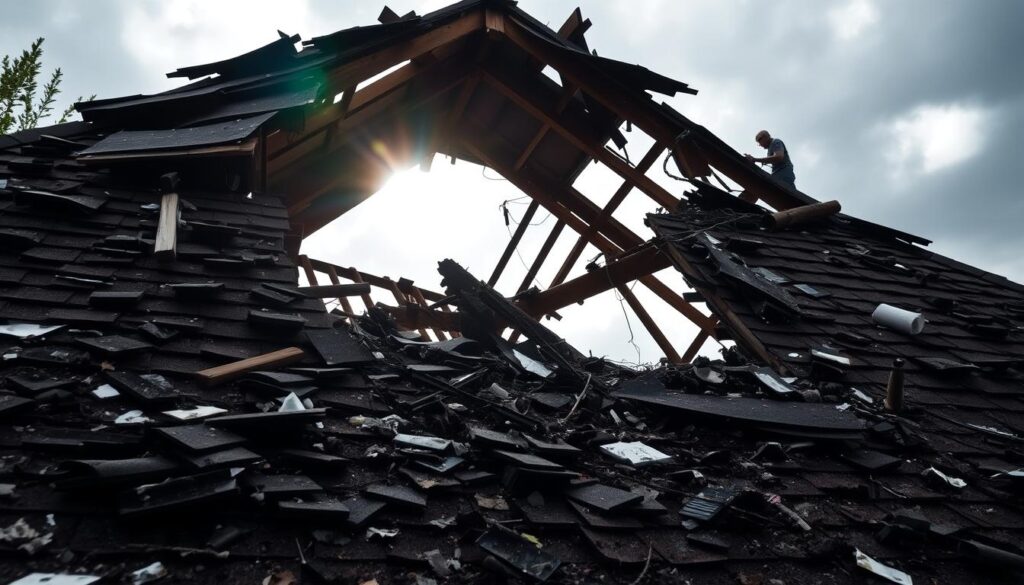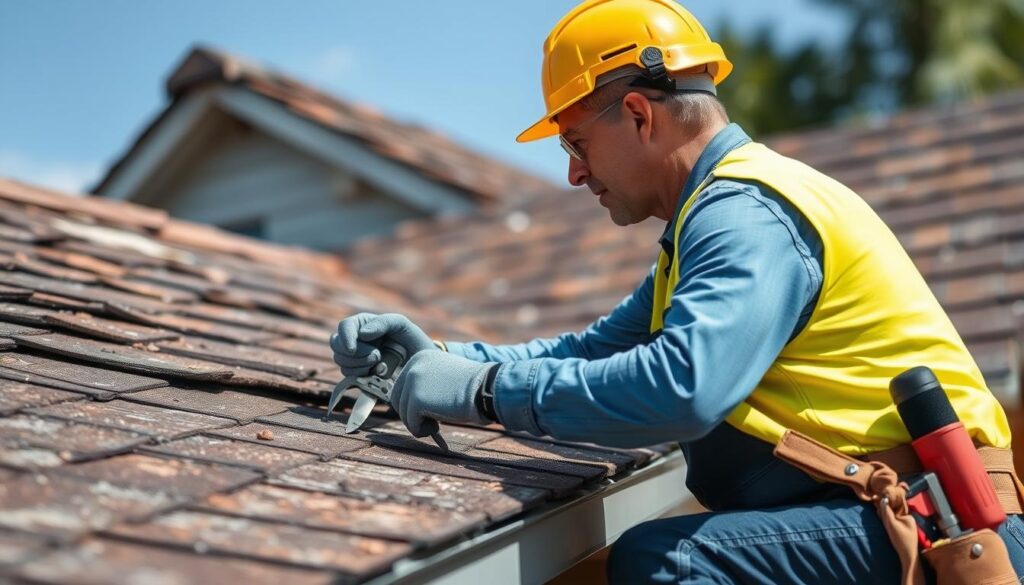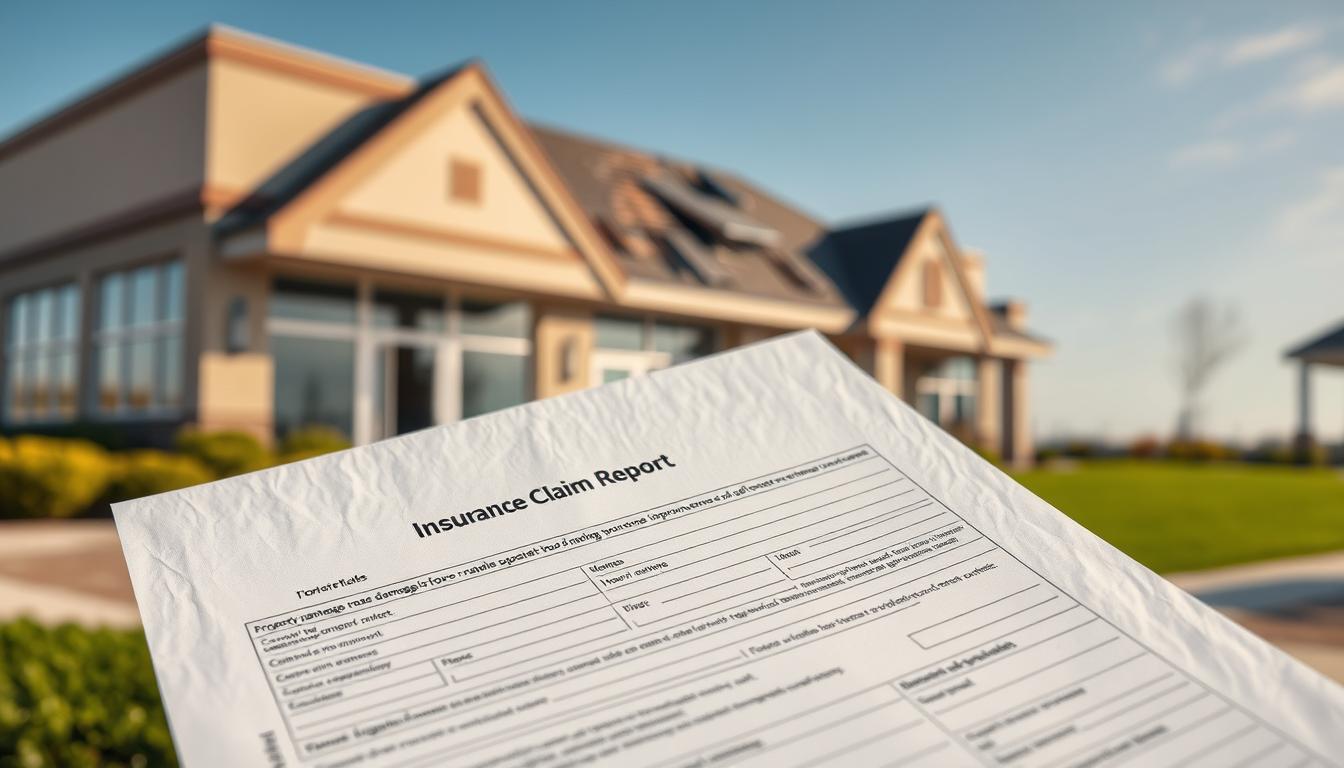When a storm damages your roof, you’ve paid your insurance premiums, expecting a smooth claims process. However, it’s frustrating when the insurance company only agrees to cover a partial replacement or repair.
Many homeowners find themselves asking, “How can I get my insurance to cover the full cost of roof replacement?” Understanding your policy and the negotiation process is crucial in securing the coverage you deserve.
I will guide you through the complex process of negotiating with insurance companies, helping you secure the coverage your business needs. By understanding your policy and properly documenting damage, you can build a strong case for your claim.
Key Takeaways
- Understand your insurance policy to navigate the negotiation process successfully.
- Proper documentation of roof damage is essential for a strong insurance claim.
- Working with an experienced roofing contractor can improve your chances of getting your claim approved.
- Effective communication strategies are crucial when negotiating with insurance adjusters.
- Knowing how to supplement your insurance claim can help secure additional coverage.
- Understanding your options if your claim is denied can help you continue pursuing the coverage you’re entitled to.
Understanding Your Insurance Policy
Knowing the intricacies of your insurance policy can make a significant difference in your claim’s outcome. When dealing with roof damage, it’s essential to understand what your policy covers and what it doesn’t.
Actual Cash Value vs. Replacement Cost Value Policies
When filing a claim, the type of policy you have can significantly impact the outcome.Replacement Cost Value (RCV) policiescover the cost of replacing your roof without deducting depreciation, whereasActual Cash Value (ACV) policiesfactor in depreciation, potentially leaving you with a lower payout. For instance, if you have an RCV policy, theinsurance companyshould cover the full cost of replacing your roof, including materials and labor.
| Policy Type | Coverage | Depreciation |
|---|---|---|
| Actual Cash Value (ACV) | Lower payout | Depreciation is factored in |
| Replacement Cost Value (RCV) | Full replacement cost | No depreciation deduction |
Key Policy Exclusions to Be Aware Of
It’s crucial to be aware of the exclusions in your policy that could affect yourroof replacement claim. Common exclusions include damage resulting from normal wear and tear, lack of maintenance, and certain weather events. For example, if your policy excludes coverage for damage caused by floods, you’ll need to purchase additional coverage. Understanding these exclusions can help you prepare for potential challenges during the claims process.

Documenting Roof Damage Properly
After a storm, it’s essential to thoroughly document the damage to your roof and property. This documentation will serve as the foundation for your insurance claim, and it’s crucial to get it right.
Taking Comprehensive Photos After Storm Damage
To start, take clear and comprehensive photos of the damage to your roof. This will help establish the extent of the damage and provide evidence for your insurance claim. When taking photos, make sure to capture the damage from multiple angles and include close-ups of specific areas. 
I recommend documenting any debris or shingles that have fallen onto your property, as this can help demonstrate the severity of the storm.
Identifying Collateral Damage on Your Property
In addition to documenting roof damage, it’s also essential to look for signs of collateral damage on your property. This can include dents in downspouts, dings to garage doors, holes in window screens, and damage to outdoor equipment. By documenting this collateral damage, you can strengthen your insurance claim and demonstrate that the damage was caused by a significant weather event.
| Collateral Damage | Description |
|---|---|
| Dents in downspouts | Check for dents above 5 feet to rule out lawnmower damage |
| Dings to garage doors | Document any strikes or dings to garage doors |
| Holes in window screens | Check for holes or tears in window screens |
| Damage to outdoor equipment | Document any damage to HVAC units, grills, or other exterior fixtures |
By thoroughly documenting both roof damage and collateral damage, you can create a comprehensive inventory of your losses and strengthen your insurance claim.
Working with a Professional Roofing Contractor

To ensure a smooth insurance claim process, it’s essential to work with a reputable and experienced roofing contractor. A professional contractor is vital in helping you navigate the complexities of the claim process.
What to Look for in an Insurance-Experienced Contractor
When selecting a contractor, look for someone who has experience with insurance claims. They should be able to provide a detailed checklist of the damage, including every line item that an insurance estimate should cover. This helps in validating your claim with the insurance company.
The Contractor’s Role in Your Insurance Claim
Your roofing contractor plays a crucial role throughout the insurance claim process. They should conduct a thorough inspection before the adjuster arrives, identifying all damage points and providing detailed documentation to support your claim. During the adjuster’s visit, they can point out damage that might otherwise be overlooked. They should also review the adjuster’s findings, help identify any discrepancies, and assist with the supplemental claim process if necessary.
By working with a professional contractor, you can ensure that your roof is properly assessed, and your claim is handled efficiently, ultimately helping you secure the coverage you deserve from your insurance company.
How to Negotiate Roof Replacement with Insurance
Negotiating roof replacement with your insurance company can be a daunting task, but with the right approach, you can achieve a successful outcome. It’s essential to understand the process and be prepared to effectively communicate your needs.
Preparing for the Insurance Adjuster’s Visit
Before the insurance adjuster visits your property, it’s crucial to document all damage thoroughly. As I always emphasize, being prepared is key to a successful claim. Take comprehensive photos and notes about the damage, including any collateral damage to your property. This documentation will serve as vital evidence when discussing your claim. According to industry experts, “A well-documented claim is more likely to be approved without significant delays or disputes.”

Ensure you have all necessary documents ready, including your policy details and any previous communication with your insurance company. Being organized will help you navigate the process more smoothly.
Effective Communication Strategies with Adjusters
When interacting with the insurance adjuster, maintaining a professional and courteous tone is vital. Focus on the facts of the damage and its impact on your property, avoiding emotional appeals. As the data suggests, avoiding admissions of fault or liability is crucial, as even casual remarks can be used against your claim. Stick to the facts and let the adjuster assess the damage without unnecessary commentary.
- Maintain a professional tone throughout all communications.
- Focus on facts rather than emotions when describing the damage.
- Document all conversations, including dates, names, and key points discussed.
- Request written explanations for any claim denials or reductions.
By being persistent yet professional, you can effectively negotiate your roof replacement with the insurance company. Knowing when to escalate issues to a supervisor is also important if you’re not making progress with the assigned adjuster.
Filing Your Roof Insurance Claim Step-by-Step
Navigating the roof insurance claim process requires patience and a clear understanding of what’s involved. To ensure a successful claim, it’s crucial to follow a structured approach. This step-by-step guide will walk you through the claim process, from initial submission to final payment.
Initial Claim Submission Process
The first step in filing your roof insurance claim is to notify your insurance company about the damage. This typically involves contacting your insurer’s claims department via phone or through their website. Be prepared to provide basic information about the damage and your policy.
Most insurance companies acknowledge claims within 24-48 hours of submission, though this timeframe may vary depending on the company and region.
What to Include in Your Documentation
When submitting your claim, it’s essential to include comprehensive documentation to support your case. This includes detailed photos of the damage, records of any correspondence with your insurer, and estimates from a professional roofing contractor. Ensuring that your documentation is thorough will help facilitate a smoother claim process.

Timeline Expectations for Claim Processing
Understanding the timeline for your roof insurance claim can help manage your expectations. After submitting your claim, an adjuster will be assigned and contact you within 3-5 business days. The physical inspection typically occurs within 1-2 weeks, followed by the initial claim decision within 1-3 weeks after inspection.
If your claim is approved, you can expect the first payment (actual cash value) within 5-10 business days of approval. The final payment (recoverable depreciation) is usually processed within 2 weeks after completing the roof replacement and submitting proof of completion.
Supplementing Your Insurance Claim
To maximize your insurance coverage, it’s vital to know how to supplement your claim effectively, ensuring that all necessary elements are included. This process involves working closely with your roofing contractor to identify and document any missing line items in the insurance company’s initial estimate.
Identifying Missing Line Items in Insurance Estimates
When reviewing your insurance estimate, it’s crucial to identify any missing elements that are essential for your roofing replacement. This includes labor costs, dump fees, overhead, and profit. A detailed, itemized list of these missing elements, along with corresponding cost information, should be compiled. Your roofing contractor can provide supporting documentation explaining why each additional item is necessary.
- Create a detailed list of missing elements with cost information.
- Include supporting documentation from your contractor.
- Reference specific building codes or manufacturer requirements.
How to Submit Supplemental Documentation
Once you have compiled the necessary documentation, it’s time to submit it to your insurance company. Ensure that you include clear photographs or diagrams illustrating the need for supplemental items. You should also reference any relevant industry standards or best practices that support your claim. Submit your documentation through the insurance company’s preferred method and follow up with a phone call to confirm receipt.

What to Do If Your Claim Is Denied
Receiving a denial for your insurance claim can be disheartening, but it’s not the end of the road. If your insurance company has denied your claim, there are several steps you can take to potentially overturn the decision.
Requesting a Second Adjuster Opinion
If you disagree with the initial assessment, you can request a second adjuster’s opinion. This can provide a fresh perspective on the damage and potentially lead to a more favorable outcome for your claim. It’s essential to review the initial adjuster’s report carefully and identify any discrepancies or areas that may have been overlooked.
Hiring a Structural Engineer for Additional Support
In some cases, hiring a roofing expert or structural engineer can provide additional support for your claim. They can assess the damage and provide a detailed report that you can submit to your insurance company. This can be particularly helpful if your claim involves complex damage that requires specialized knowledge.
Filing a Complaint with Your State’s Insurance Commissioner
If all else fails, you may need to file a complaint with your state’s insurance commissioner. This should be a last resort, but it can be an effective way to resolve disputes with your insurance company. The process involves compiling a detailed chronology of your claim and submitting it along with relevant documentation. Be prepared for this process to take time.
| Step | Description | Timeline |
|---|---|---|
| Request Second Adjuster Opinion | Review initial report, identify discrepancies | 1-2 weeks |
| Hire Structural Engineer | Assess damage, provide detailed report | 2-4 weeks |
| File Complaint with Commissioner | Compile chronology, submit documentation | Several weeks to months |
Conclusion: Securing the Coverage You Deserve
Empowering yourself with the right information is crucial when dealing with insurance claims for roof replacement. Throughout this article, I’ve guided you through the comprehensive process, from understanding your policy to handling claim denials. Preparation is key; documenting damage thoroughly and understanding your policy terms gives you the strongest position for negotiation. Working with experienced professionals, including reputable roofing contractors, improves your chances of claim approval. By following these strategies, you’re now better equipped to negotiate roof replacement and secure the coverage you deserve.
FAQ
What’s the difference between Actual Cash Value (ACV) and Replacement Cost Value (RCV) policies?
ACV policies factor in depreciation when determining payout, whereas RCV policies cover the full cost of replacing or repairing damaged property without considering depreciation.
How do I know if my insurance policy covers storm damage to my roof?
Review your policy documents or consult with your insurance provider to understand what’s covered and what’s excluded. Look for sections related to storm damage, wind damage, or hail damage.
What should I look for in a roofing contractor to ensure they’re insurance-experienced?
Check for certifications, licenses, and reviews from previous clients. A reputable contractor should be able to guide you through the insurance claim process and provide documentation to support your claim.
Can I file a claim for roof damage if it’s partially damaged?
Yes, you can file a claim even if your roof is partially damaged. Document the damage thoroughly, and work with your insurance adjuster to determine the extent of the damage and the necessary repairs.
What’s the typical timeline for processing an insurance claim for roof damage?
The processing time varies depending on the complexity of the claim, the insurance company’s workload, and the adjuster’s schedule. Generally, it can take anywhere from a few days to several weeks or even months.
Can I request a second adjuster opinion if I’m not satisfied with the initial assessment?
Yes, you can request a second adjuster opinion or seek the assistance of a public adjuster to help negotiate your claim. This can be particularly helpful if you feel the initial assessment was inaccurate or incomplete.
How do I identify missing line items in insurance estimates for my roof replacement?
Carefully review the estimate provided by your insurance company, and compare it to the assessment from your roofing contractor. Look for discrepancies or omissions, and be prepared to submit supplemental documentation to support your claim.
What happens if my insurance claim is denied?
If your claim is denied, you can request a reconsideration, file a complaint with your state’s insurance commissioner, or seek the assistance of a public adjuster or attorney to help resolve the issue.





